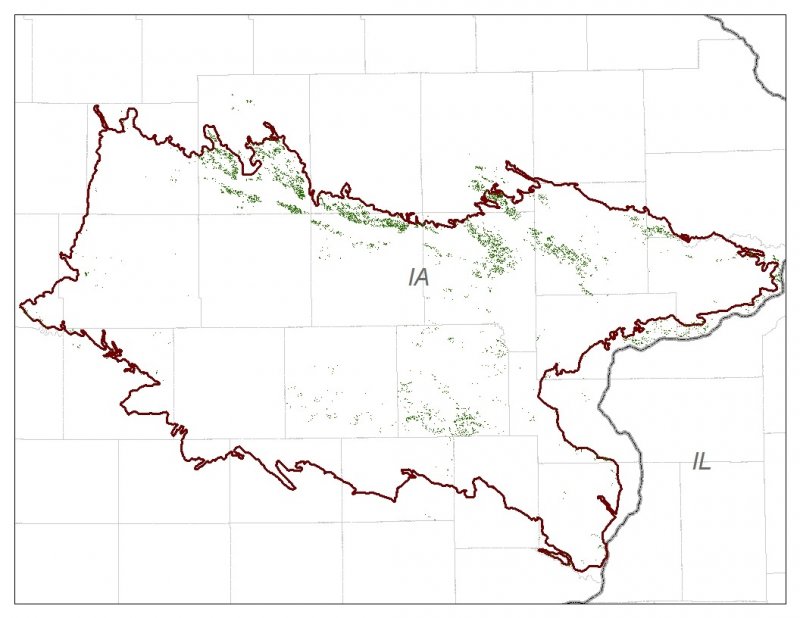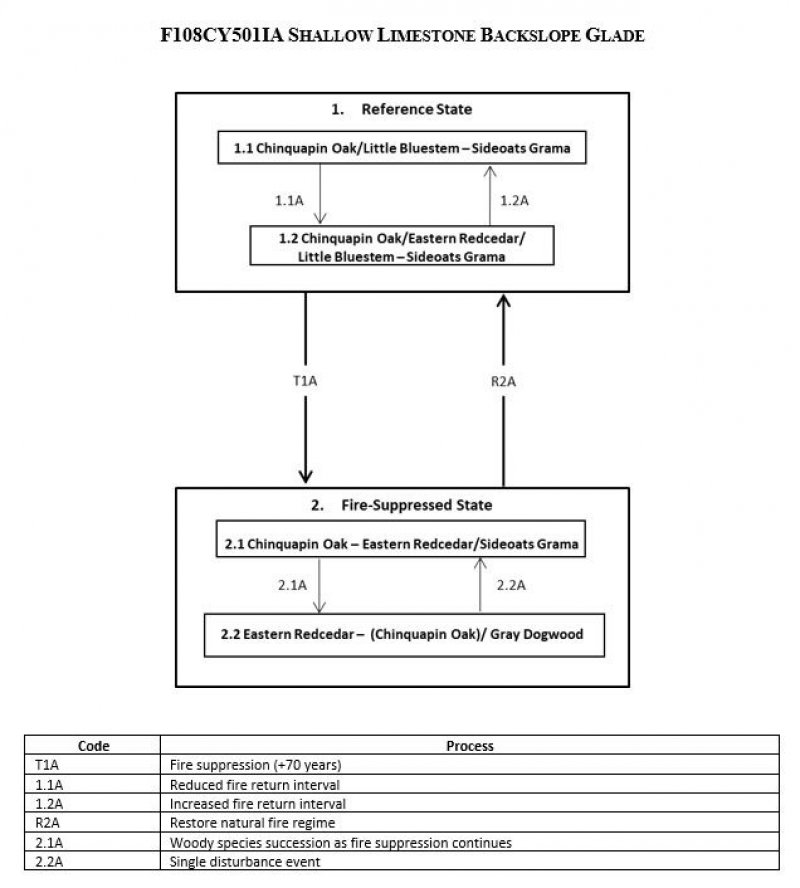
Natural Resources
Conservation Service
Ecological site F108XC501IA
Shallow Limestone Backslope Glade
Last updated: 11/04/2024
Accessed: 12/21/2025
General information
Provisional. A provisional ecological site description has undergone quality control and quality assurance review. It contains a working state and transition model and enough information to identify the ecological site.
Figure 1. Mapped extent
Areas shown in blue indicate the maximum mapped extent of this ecological site. Other ecological sites likely occur within the highlighted areas. It is also possible for this ecological site to occur outside of highlighted areas if detailed soil survey has not been completed or recently updated.
MLRA notes
Major Land Resource Area (MLRA): 108X–Illinois and Iowa Deep Loess and Drift
The Illinois and Iowa Deep Loess and Drift, West-Central Part (MLRA 108C) encompasses the eastern portion of the Southern Iowa Drift Plain and the Lake Calvin Basin of the Mississippi Alluvial Plain landforms (Prior 1991). It lies entirely in one state (Iowa), containing approximately 9,805 square miles (Figure 1). The elevation ranges from approximately 1,110 feet above sea level (ASL) on the highest ridges to about 505 feet ASL in the lowest valleys. Local elevation difference is mainly 10 to 20 feet. However, some valley floors can range from 80 to 200 feet, while some upland flats and valley floors only range between 3 and 6 feet. The MLRA is underlain by Pre-Illinoian glacial till, deposited more than 500,000 years ago and since undergone extensive erosion and dissection. In the northern half of the area the till thickness ranges from 150 to 350 feet and grades to less than 150 feet thick in the southern half. The till is covered by a mantle of Peoria Loess on the hillslopes and Holocene alluvium in the drainageways. Paleozoic bedrock, comprised of limestone, shale, and mudstones, lies beneath the glacial material (USDA-NRCS 2006).
The vegetation in the MLRA has undergone drastic changes over time. Spruce forests dominated the landscape 30,000 to 21,500 years ago. As the last glacial maximum peaked 21,500 to 16,000 years ago, they were replaced with open tundras and parklands. The end of the Pleistocene Epoch saw a warming climate that initially prompted the return of spruce forests, but as the warming continued, spruce trees were replaced by deciduous trees (Baker et al. 1990). Not until approximately 9,000 years ago did the vegetation transition to prairies as climatic conditions continued to warm and subsequently dry. Between 4,000 and 3,000 years ago, oak savannas began intermingling within the prairie landscape, while the more wooded and forested areas maintained a foothold in sheltered areas. This prairie-forest transition ecosystem formed the dominant landscapes until the arrival of European settlers (Baker et al. 1992).
Classification relationships
USFS Subregions: Central Dissected Till Plains (251C) Section, Central Dissected Till and Loess Plain (251Cc), Mississippi River and Illinois Alluvial Plains (51Cf), Southeast Iowa Rolling Loess Hills (251Ch) Subsections (Cleland et al. 2007)
U.S. EPA Level IV Ecoregion: Rolling Loess Prairies (47f), Upper Mississippi Alluvial Plain (72d) (USEPA 2013)
National Vegetation Classification – Ecological Systems: Central Interior Highlands Calcareous Glade and Barrens (CES202.691); Central Interior Calcareous Cliff and Talus (CES202.690) (NatureServe 2015)
National Vegetation Classification - Plant Associations: Quercus muehlenbergii/Schizachyrium scoparium – Bouteloua curtipendula Wooded Grassland (CEGL005284); Limestone – Dolomite Midwest Moist Cliff Vegetation (CEGL002292); Limestone – Dolomite Midwest Dry Cliff Sparse Vegetation (CEGL002291) (Nature Serve 2015)
Biophysical Settings: Central Interior Highlands Calcareous Glade and Barrens (BpS 4314010) (LANDFIRE 2009)
Iowa Department of Natural Resources: Limestone Glade (INAI 1984)
Ecological site concept
Shallow Limestone Backslope Glades are located within the blue areas on the map (Figure 1). They occur on upland backslopes on slopes greater than 15 percent. The soils are Alfisols that are well-drained and shallow (less than 40 cm) formed in silty or loamy sediments over limestone bedrock.
The historic pre-European settlement vegetation on this ecological site was dominated by sparse woody and herbaceous plants tolerant of very dry conditions (INAI 1984; LANDFIRE 2009). Chinquapin oak (Quercus muehlenbergii Engelm.) is the dominant tree, and little bluestem (Schizachyrium scoparium (Michx.) Nash) and sideoats grama (Bouteloua curtipendula (Michx.) Torr.) are the dominant understory grass species. Other grasses present can include Indiangrass (Sorghastrum nutans (L.) Nash) and big bluestem (Andropogon gerardii Vitman). Overall vegetation cover is low and limestone bedrock occasionally occurs at the surface. Fire is the primary disturbance factor maintaining this site, and drought and storm damage are secondary factors (LANDFIRE 2009; NatureServe 2015).
Associated sites
| F108XC513IA |
Till Backslope Forest Glacial till parent material on backslopes including Bertrand, Douds, Galland, Inton, Lindley, and Russell |
|---|---|
| F108XC502IA |
Shallow Sandstone Backslope Glade Silty or loamy sediments over sandstone on backslopes including Boone, Eleva, and Gale |
| F108XC505IA |
Loess Upland Woodland Loess parent material on upland summits, shoulders, and upper to mid backslopes including Clinton, Exette, Hayette, Mula, Rozetta, Seaton, and Timula |
Similar sites
| F108XC502IA |
Shallow Sandstone Backslope Glade Shallow Sandstone Backslope Glades occur in similar landscape positions but over sandstone bedrock |
|---|
Table 1. Dominant plant species
| Tree |
(1) Quercus muehlenbergii |
|---|---|
| Shrub |
Not specified |
| Herbaceous |
(1) Schizachyrium scoparium |
Click on box and path labels to scroll to the respective text.




